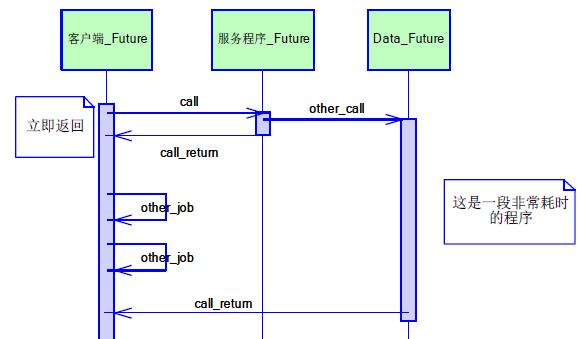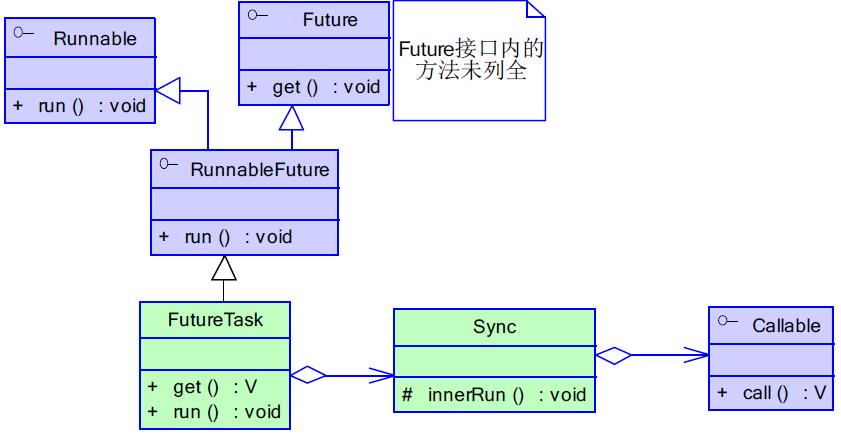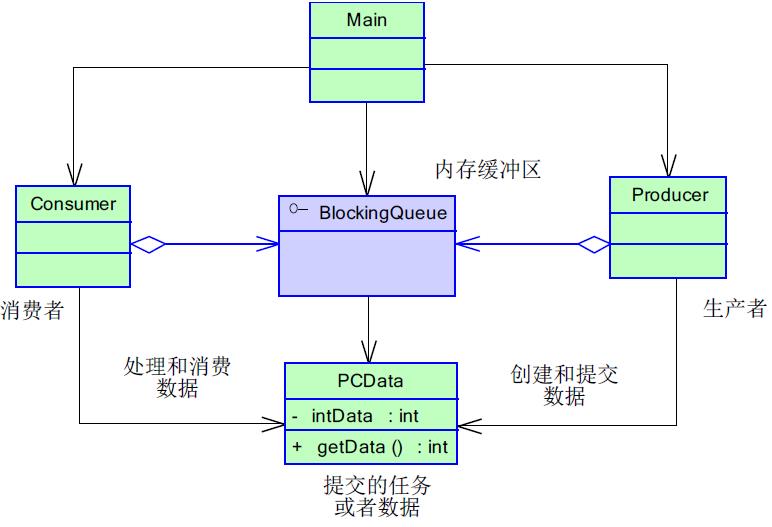Java高并发之设计模式.
Posted 大道方圆
tags:
篇首语:本文由小常识网(cha138.com)小编为大家整理,主要介绍了Java高并发之设计模式.相关的知识,希望对你有一定的参考价值。
本文主要讲解几种常见并行模式, 具体目录结构如下图.

单例
单例是最常见的一种设计模式, 一般用于全局对象管理, 比如xml配置读写之类的.
一般分为懒汉式, 饿汉式.
懒汉式: 方法上加synchronized
1 public static synchronized Singleton getInstance() { 2 if (single == null) { 3 single = new Singleton(); 4 } 5 return single; 6 }
这种方式, 由于每次获取示例都要获取锁, 不推荐使用, 性能较差
懒汉式: 使用双检锁 + volatile
1 private volatile Singleton singleton = null; 2 public static Singleton getInstance() { 3 if (singleton == null) { 4 synchronized (Singleton.class) { 5 if (singleton == null) { 6 singleton = new Singleton(); 7 } 8 } 9 } 10 return singleton; 11 }
本方式是对直接在方法上加锁的一个优化, 好处在于只有第一次初始化获取了锁.
后续调用getInstance已经是无锁状态. 只是写法上稍微繁琐点.
至于为什么要volatile关键字, 主要涉及到jdk指令重排, 详见之前的博文: Java内存模型与指令重排
懒汉式: 使用静态内部类
1 public class Singleton { 2 private static class LazyHolder { 3 private static final Singleton INSTANCE = new Singleton(); 4 } 5 private Singleton (){} 6 public static final Singleton getInstance() { 7 return LazyHolder.INSTANCE; 8 } 9 }
该方式既解决了同步问题, 也解决了写法繁琐问题. 推荐使用改写法.
缺点在于无法响应事件来重新初始化INSTANCE.
饿汉式
1 public class Singleton1 { 2 private Singleton1() {} 3 private static final Singleton1 single = new Singleton1(); 4 public static Singleton1 getInstance() { 5 return single; 6 } 7 }
缺点在于对象在一开始就直接初始化了.
Future模式
该模式的核心思想是异步调用. 有点类似于异步的ajax请求.
当调用某个方法时, 可能该方法耗时较久, 而在主函数中也不急于立刻获取结果.
因此可以让调用者立刻返回一个凭证, 该方法放到另外线程执行,
后续主函数拿凭证再去获取方法的执行结果即可, 其结构图如下

jdk中内置了Future模式的支持, 其接口如下:

通过FutureTask实现
注意其中两个耗时操作.
- 如果doOtherThing耗时2s, 则整个函数耗时2s左右.
- 如果doOtherThing耗时0.2s, 则整个函数耗时取决于RealData.costTime, 即1s左右结束.
1 public class FutureDemo1 { 2 3 public static void main(String[] args) throws InterruptedException, ExecutionException { 4 FutureTask<String> future = new FutureTask<String>(new Callable<String>() { 5 @Override 6 public String call() throws Exception { 7 return new RealData().costTime(); 8 } 9 }); 10 ExecutorService service = Executors.newCachedThreadPool(); 11 service.submit(future); 12 13 System.out.println("RealData方法调用完毕"); 14 // 模拟主函数中其他耗时操作 15 doOtherThing(); 16 // 获取RealData方法的结果 17 System.out.println(future.get()); 18 } 19 20 private static void doOtherThing() throws InterruptedException { 21 Thread.sleep(2000L); 22 } 23 } 24 25 class RealData { 26 27 public String costTime() { 28 try { 29 // 模拟RealData耗时操作 30 Thread.sleep(1000L); 31 return "result"; 32 } catch (InterruptedException e) { 33 e.printStackTrace(); 34 } 35 return "exception"; 36 } 37 38 }
通过Future实现
与上述FutureTask不同的是, RealData需要实现Callable接口.
1 public class FutureDemo2 { 2 3 public static void main(String[] args) throws InterruptedException, ExecutionException { 4 ExecutorService service = Executors.newCachedThreadPool(); 5 Future<String> future = service.submit(new RealData2()); 6 7 System.out.println("RealData2方法调用完毕"); 8 // 模拟主函数中其他耗时操作 9 doOtherThing(); 10 // 获取RealData2方法的结果 11 System.out.println(future.get()); 12 } 13 14 private static void doOtherThing() throws InterruptedException { 15 Thread.sleep(2000L); 16 } 17 } 18 19 class RealData2 implements Callable<String>{ 20 21 public String costTime() { 22 try { 23 // 模拟RealData耗时操作 24 Thread.sleep(1000L); 25 return "result"; 26 } catch (InterruptedException e) { 27 e.printStackTrace(); 28 } 29 return "exception"; 30 } 31 32 @Override 33 public String call() throws Exception { 34 return costTime(); 35 } 36 }
另外Future本身还提供了一些额外的简单控制功能, 其API如下
1 // 取消任务 2 boolean cancel(boolean mayInterruptIfRunning); 3 // 是否已经取消 4 boolean isCancelled(); 5 // 是否已经完成 6 boolean isDone(); 7 // 取得返回对象 8 V get() throws InterruptedException, ExecutionException; 9 // 取得返回对象, 并可以设置超时时间 10 V get(long timeout, TimeUnit unit) 11 throws InterruptedException, ExecutionException, TimeoutException;
生产消费者模式
生产者-消费者模式是一个经典的多线程设计模式. 它为多线程间的协作提供了良好的解决方案。
在生产者-消费者模式中,通常由两类线程,即若干个生产者线程和若干个消费者线程。
生产者线程负责提交用户请求,消费者线程则负责具体处理生产者提交的任务。
生产者和消费者之间则通过共享内存缓冲区进行通信, 其结构图如下

PCData为我们需要处理的元数据模型, 生产者构建PCData, 并放入缓冲队列.
消费者从缓冲队列中获取数据, 并执行计算.
生产者核心代码
1 while(isRunning) { 2 Thread.sleep(r.nextInt(SLEEP_TIME)); 3 data = new PCData(count.incrementAndGet); 4 // 构造任务数据 5 System.out.println(data + " is put into queue"); 6 if (!queue.offer(data, 2, TimeUnit.SECONDS)) { 7 // 将数据放入队列缓冲区中 8 System.out.println("faild to put data : " + data); 9 } 10 }
消费者核心代码
1 while (true) { 2 PCData data = queue.take(); 3 // 提取任务 4 if (data != null) { 5 // 获取数据, 执行计算操作 6 int re = data.getData() * 10; 7 System.out.println("after cal, value is : " + re); 8 Thread.sleep(r.nextInt(SLEEP_TIME)); 9 } 10 }
生产消费者模式可以有效对数据解耦, 优化系统结构.
降低生产者和消费者线程相互之间的依赖与性能要求.
一般使用BlockingQueue作为数据缓冲队列, 他是通过锁和阻塞来实现数据之间的同步,
如果对缓冲队列有性能要求, 则可以使用基于CAS无锁设计的ConcurrentLinkedQueue.
分而治之
严格来讲, 分而治之不算一种模式, 而是一种思想.
它可以将一个大任务拆解为若干个小任务并行执行, 提高系统吞吐量.
我们主要讲两个场景, Master-Worker模式, ForkJoin线程池.
Master-Worker模式
该模式核心思想是系统由两类进行协助工作: Master进程, Worker进程.
Master负责接收与分配任务, Worker负责处理任务. 当各个Worker处理完成后,
将结果返回给Master进行归纳与总结.

假设一个场景, 需要计算100个任务, 并对结果求和, Master持有10个子进程.
Master代码
1 public class MasterDemo { 2 // 盛装任务的集合 3 private ConcurrentLinkedQueue<TaskDemo> workQueue = new ConcurrentLinkedQueue<TaskDemo>(); 4 // 所有worker 5 private HashMap<String, Thread> workers = new HashMap<>(); 6 // 每一个worker并行执行任务的结果 7 private ConcurrentHashMap<String, Object> resultMap = new ConcurrentHashMap<>(); 8 9 public MasterDemo(WorkerDemo worker, int workerCount) { 10 // 每个worker对象都需要持有queue的引用, 用于领任务与提交结果 11 worker.setResultMap(resultMap); 12 worker.setWorkQueue(workQueue); 13 for (int i = 0; i < workerCount; i++) { 14 workers.put("子节点: " + i, new Thread(worker)); 15 } 16 } 17 18 // 提交任务 19 public void submit(TaskDemo task) { 20 workQueue.add(task); 21 } 22 23 // 启动所有的子任务 24 public void execute(){ 25 for (Map.Entry<String, Thread> entry : workers.entrySet()) { 26 entry.getValue().start(); 27 } 28 } 29 30 // 判断所有的任务是否执行结束 31 public boolean isComplete() { 32 for (Map.Entry<String, Thread> entry : workers.entrySet()) { 33 if (entry.getValue().getState() != Thread.State.TERMINATED) { 34 return false; 35 } 36 } 37 38 return true; 39 } 40 41 // 获取最终汇总的结果 42 public int getResult() { 43 int result = 0; 44 for (Map.Entry<String, Object> entry : resultMap.entrySet()) { 45 result += Integer.parseInt(entry.getValue().toString()); 46 } 47 48 return result; 49 } 50 51 }
Worker代码
1 public class WorkerDemo implements Runnable{ 2 3 private ConcurrentLinkedQueue<TaskDemo> workQueue; 4 private ConcurrentHashMap<String, Object> resultMap; 5 6 @Override 7 public void run() { 8 while (true) { 9 TaskDemo input = this.workQueue.poll(); 10 // 所有任务已经执行完毕 11 if (input == null) { 12 break; 13 } 14 // 模拟对task进行处理, 返回结果 15 int result = input.getPrice(); 16 this.resultMap.put(input.getId() + "", result); 17 System.out.println("任务执行完毕, 当前线程: " + Thread.currentThread().getName()); 18 } 19 } 20 21 public ConcurrentLinkedQueue<TaskDemo> getWorkQueue() { 22 return workQueue; 23 } 24 25 public void setWorkQueue(ConcurrentLinkedQueue<TaskDemo> workQueue) { 26 this.workQueue = workQueue; 27 } 28 29 public ConcurrentHashMap<String, Object> getResultMap() { 30 return resultMap; 31 } 32 33 public void setResultMap(ConcurrentHashMap<String, Object> resultMap) { 34 this.resultMap = resultMap; 35 } 36 }

1 public class TaskDemo { 2 3 private int id; 4 private String name; 5 private int price; 6 7 public int getId() { 8 return id; 9 } 10 11 public void setId(int id) { 12 this.id = id; 13 } 14 15 public String getName() { 16 return name; 17 } 18 19 public void setName(String name) { 20 this.name = name; 21 } 22 23 public int getPrice() { 24 return price; 25 } 26 27 public void setPrice(int price) { 28 this.price = price; 29 } 30 }
主函数测试
1 MasterDemo master = new MasterDemo(new WorkerDemo(), 10); 2 for (int i = 0; i < 100; i++) { 3 TaskDemo task = new TaskDemo(); 4 task.setId(i); 5 task.setName("任务" + i); 6 task.setPrice(new Random().nextInt(10000)); 7 master.submit(task); 8 } 9 10 master.execute(); 11 12 while (true) { 13 if (master.isComplete()) { 14 System.out.println("执行的结果为: " + master.getResult()); 15 break; 16 } 17 }
ForkJoin线程池
该线程池是jdk7之后引入的一个并行执行任务的框架, 其核心思想也是将任务分割为子任务,
有可能子任务还是很大, 还需要进一步拆解, 最终得到足够小的任务.
将分割出来的子任务放入双端队列中, 然后几个启动线程从双端队列中获取任务执行.
子任务执行的结果放到一个队列里, 另起线程从队列中获取数据, 合并结果.

假设我们的场景需要计算从0到20000000L的累加求和. CountTask继承自RecursiveTask, 可以携带返回值.
每次分解大任务, 简单的将任务划分为100个等规模的小任务, 并使用fork()提交子任务.
在子任务中通过THRESHOLD设置子任务分解的阈值, 如果当前需要求和的总数大于THRESHOLD, 则子任务需要再次分解,
如果子任务可以直接执行, 则进行求和操作, 返回结果. 最终等待所有的子任务执行完毕, 对所有结果求和.
1 public class CountTask extends RecursiveTask<Long>{ 2 // 任务分解的阈值 3 private static final int THRESHOLD = 10000; 4 private long start; 5 private long end; 6 7 8 public CountTask(long start, long end) { 9 this.start = start; 10 this.end = end; 11 } 12 13 public Long compute() { 14 long sum = 0; 15 boolean canCompute = (end - start) < THRESHOLD; 16 if (canCompute) { 17 for (long i = start; i <= end; i++) { 18 sum += i; 19 } 20 } else { 21 // 分成100个小任务 22 long step = (start + end) / 100; 23 ArrayList<CountTask> subTasks = new ArrayList<CountTask>(); 24 long pos = start; 25 for (int i = 0; i < 100; i++) { 26 long lastOne = pos + step; 27 if (lastOne > end) { 28 lastOne = end; 29 } 30 CountTask subTask = new CountTask(pos, lastOne); 31 pos += step + 1; 32 // 将子任务推向线程池 33 subTasks.add(subTask); 34 subTask.fork(); 35 } 36 37 for (CountTask task : subTasks) { 38 // 对结果进行join 39 sum += task.join(); 40 } 41 } 42 return sum; 43 } 44 45 public static void main(String[] args) throws ExecutionException, InterruptedException { 46 ForkJoinPool pool = new ForkJoinPool(); 47 // 累加求和 0 -> 20000000L 48 CountTask task = new CountTask(0, 20000000L); 49 ForkJoinTask<Long> result = pool.submit(task); 50 System.out.println("sum result : " + result.get()); 51 } 52 }
ForkJoin线程池使用一个无锁的栈来管理空闲线程, 如果一个工作线程暂时取不到可用的任务, 则可能被挂起.
挂起的线程将被压入由线程池维护的栈中, 待将来有任务可用时, 再从栈中唤醒这些线程.
以上是关于Java高并发之设计模式.的主要内容,如果未能解决你的问题,请参考以下文章
